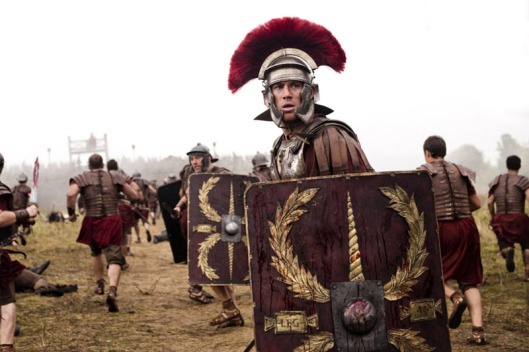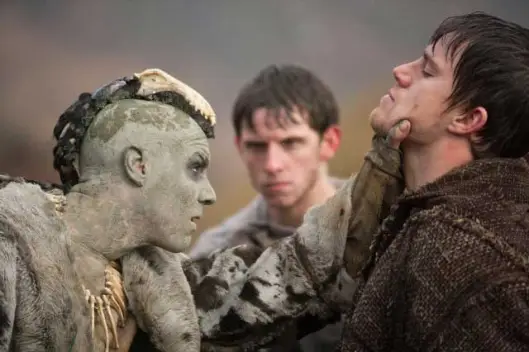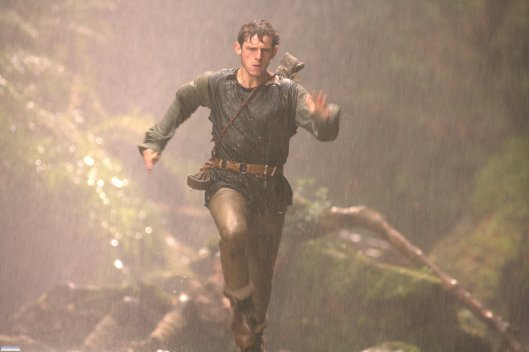Tags
Channing Tatum, Jamie Bell, Roman Britain, Roman Scotland, Rosemary Sutcliff, The Eagle, The Eagle of the Ninth
My previous post on The Eagle (2011, dir. Kevin McDonald) took issue with the film’s terrible prologue text. So let’s look at the film itself and see what there is to say about it.

The Eagle’s plot focuses on Marcus Flavius Aquila (Channing Tatum), and for once a Hollywood film gets the Roman names right. His father was the commander of the ill-fated 9th Legion, lost in Scotland a generation before. Initially, he wants to make up his family’s dishonor through military service, but in a battle with the Celts he suffers a leg injury that leads to his honorable discharge. So he decides to travel into Scotland seeking the lost Eagle Standard of the 9th Legion. He is accompanied only by Esca (Jamie Bell), a slave that he rescued from a gladiatorial fight.
Once they are north of Hadrian’s Wall, Marcus becomes heavily dependant on Esca, who can communicate with the Picts when Marcus can’t. Eventually they discover that the Seal People have the Eagle. The Seal People chieftain (Ned Dennehy) welcomes Esca, who claims that Marcus is his slave. Esca figures out where the Eagle is kept and they steal it, but in the process they slay the chieftain and must flee back toward the Wall, pursued by the Prince of the Seal People (Tahar Rahim) and their warriors.

Tatum as Marcus
When it looks like the will be overtaken, Esca manages to find the survivors of the 9th Legion, who have been living among the Picts. He persuades them to stand and fight for their lost honor, and this motley army manages to deal with the Prince of the Seal People and the other warriors, thus enabling Marcus and Esca to return the Eagle Standard to the Roman authorities.
The film has a simple plot, and despite the somewhat improbable final battle, the film works as a modest story of a man recovering his family’s honor through a single brave deed. It doesn’t try to be more than it is, and it avoids the grandiosity that so many action films have these days. A particularly effective sub-plot is the relationship between Marcus and Esca, who begin as master and slave, then have that relationship literally inverted, before finally become friends. Esca’s loyalty to the man who saved his life is a familiar film trope, but it works here perhaps because the source material is a Young Adult novel; the earnestness of the moral point feels genuine, and Bell does an excellent job with his character’s evolution. Tatum’s modest acting skills actually work to his advantage here; he conveys the appropriate Roman Stoicism nicely.
What’s North of the Wall?
In the film, the people north of the Wall are referred to in passing as the Picts, but other than that, the film doesn’t identify them, and it’s clear that the Seal People are just one tribe in the region. The Seal People dress differently from the other peoples Marcus and Esca talk to; in particular their warriors coat their bodies with some sort of mud or brownish body paint.
Historically, as I’ve discussed before, the people living in what is today Scotland in the 2nd century were not Picts, but rather Caledonians. The exact relationship between the Caledonians and the later Picts is unclear (since neither was a literate people, and the Romans wrote about them only in passing), but Pictish society may have emerged out of a collapsed Caledonian society. But the term Picti (Latin for ‘painted ones’) only occurs in the later 3rd century. In the 2nd century, soldiers at Hadrian’s Wall used the term Brittunculi (roughly, ‘nasty little Britons’).

The Seal Prince (Rahim) threatening Marcus while Esca watches
So the film is, like all films about Roman Scotland, simplifying by projecting Pictish society back in time a little bit. But at least these Picts aren’t painting themselves blue the way most cinematic Scottish people do.
Another problem with the film’s depiction of Caledonia/Pictland/Scotland (for convenience, I’ll just call it Scotland) is that once the characters pass Hadrian’s Wall, they are in a sparsely-inhabited wilderness where no one knows Latin at all, thus making Marcus rely on Esca’s knowledge of the Celtic language.
There are a couple issues here. First, the film finesses the language issue a bit. We don’t know what language the Picts spoke. Scholars have debated whether Pictish was a branch of the Celtic language or a totally unrelated indigenous language. Esca is a Brigantes, the Celtic tribe in northern England, so if Pictish was a branch of Gaelic it’s reasonable to assume that he could have muddled his way through simple conversations with people who spoke a related language. But if Pictish was unrelated to Gaelic, it’s less plausible. But the film does a decent job of trying to handle the language issue. The Seal People speak modern Scots and Irish Gaelic, and the film went to the trouble to casting actors who actually know those languages rather than just giving them a dialect coach.

As I’ve mentioned before, skin-tight leather wasn’t a thing back then
Another problem is that the film is set in the 140s, about 20 years after the 9th Legion’s supposed destruction. But in the 140s and 150s, the Romans were attempting the occupation of southern Scotland, so that Hadrian’s Wall would not have been the Roman frontier at all, and it is likely that people north of the Antonine Wall (the new frontier) would have been more familiar with the Romans than this film suggests. And Scotland wouldn’t have been desolate and unoccupied as the film suggests.
But we can probably forgive these mistakes. Explaining that Britain had two Roman frontier walls would have been more complicated than it was worth. The film never directly explains the geography. It’s unclear just how far north Marcus and Esca go before they find the Seal People, although the geography suggests northern Scotland (and in fact the film used a location in northwestern Scotland for the Seal People village).
If you analyze it too closely, the geography doesn’t really work. The 9th Legion marched into Scotland and got wiped out in an ambush by the tribes in the region. This seems likely to have happened somewhere in southern Scotland—how could they have marched all the way north without encountering resistance and only then get ambushed? But if they were ambushed in southern Scotland, why were the Seal People involved? The surviving Romans appear to be living 1-2 days south of where the Seal People live, suggesting that Marcus and Esca traveled the length of Scotland and barely ran into anyone on the way, but if Scotland is that depopulated, it seems unlikely that there were enough Picts to annihilate a whole legion of about 5,000 men. But that’s a small quibble. The film is compressing geography for the sake of story, and that’s entirely reasonable.
One very nice touch is that the film gets the difference between Roman and Celtic fighting systems correct in the two battle scenes it shows. The Romans are heavily armored and employ complex tactics like the testudo, whereas the Celts are essentially naked and rely on swarming the enemy and using raw fury to overpower their opponents. This explains why a small Roman force is able to prevail over a much larger group of enemies. Unlike in most historical action films, armor actually has protective value and brute force doesn’t win the day.

The Roman testudo
In my next post, I’m excited to be able to offer an interview with Lindsay Allason-Jones, the historical consultant on the film!
Want to Know More?
The Eagle is available on Amazon. Sutcliff’s original novel (and its two sequels) is too.
If you’re interested in Roman-era Scotland, there are not a lot of books on the topic, but David Breeze has written a number of works on the subject, including the appropriately-titled Roman Scotland and The Antonine Wall. There’s David Shotter’s The Roman Frontier in Britain: Hadrian’s Wall, the Antonine Wall and Roman Policy in Scotland.





Quick question: did they get the direction of Marcus’ helmet right in that opening battle scene? It’s become something of a common mistake in movies featuring the Greek army (I.E. 300) to have the plumage facing forward when I’ve read it’s supposed to be facing sideways. Here they get it right but I was wondering if that was still the case by the time of the Roman legions of 200 AD or not?
LikeLike
Oh, dear, you’ve asked me to get into the minutiae of ancient Roman armor. The so-called Imperial Gallic helmet style had the sideways crest certainly into the early 2nd century, but how much later they were used I’m not sure of. So if they were not used by the 140s, the film would only be off by about a generation.
LikeLike
The chin strap scare identifier is also a nice tidbit. Any historical evidence of that being a real thing?
LikeLike
I think that was added for the audience. It seems unlikely to me, and it wouldn’t show archaeologically.
LikeLike
Correct me if I’m wrong, but wasn’t the sideways crest associated with centurions in the 1st-2nd centuries? Is the military rank of Marcus ever mentioned? I’m pretty sure the rank-and-file legionary did not wear a crest at all.
Also, wouldn’t legionaries of the period wear chain mail or the lorica segmentata? It seems like the common soldiers are wearing a leather version of the lorica, and I have no idea what Marcus is wearing.
LikeLiked by 1 person
In the book, Marcus is the commander of a whole legion. In the movie he’s a centurion.
LikeLike
As someone who seriously studies the Picts, this movie made me drink, heavily. As you said, at least they were not painted blue, but generally it was just crazy-making. It’s been years since I’ve seen it and it has mostly faded from memory… Thank the gods and Scotch.
LikeLike
If it makes you feel better, just think of them as mis-named Caledonians. We know so little about the Caledonians that the film’s hypothetical reconstruction of their society isn’t outrageous, although I think it’s mostly speculative
LikeLike
It does, except that I know most audiences won’t do the appropriate correction and so the misperceptions are perpetuated. I’m also not buying the perpetually smeared in mud and lime thing, even for Caledonians.
LikeLike
Yes, it’s rather far-fetched. But, in fairness of the film, it’s only the warriors who wear the mud, so it’s clear that it’s something ceremonial or status-related, not just these people being dirty.
LikeLike
The Seal People reminded me less of ancient people of Scotland than Native Americans from the East Coast like the Mohawks or Hurrons.
LikeLike
Yeah, although with a very low level of technology that’s not too surprising.
LikeLike
Above when discussing language you specifically mention pictish potentially being related to Gaelic . Are you simply rolling all Celtic languages together a s “gaelic”? Or do we have evidence pointing towards Brigantes speaking a Gaelic language? As a British tribe you’d assume they be speaking a brittonic language. And I’m unsure when Irish influence brought Gaelic language into Scotland.
Either way if Caledonian/pictish was a distinct Celtic language family . You’ve got 3 distinct language families running around the British isles. Given that modern languages in the same family aren’t exactly mutually intelligible. Even if both are Brittonic or Gaelic, there’s no guarantee things are all that similar across borders. I’ve never exactly bought that trope. And it seems reallly common with these Roman Britain flicks. “he speaks Celt! Grab him!”
LikeLiked by 1 person
That’s a good question. I didn’t went to get into the whole question of P-Gaelic vs Q-Gaelic and all of that, particularly since I’m not a linguist. So I simplified the issue a good deal.
My understanding is that the name ‘Brigantes’ has a porto-Celtic root. Their queen Cartimandua has a name that uses Celtic roots. So I think it’s accepted that they spoke some branch of the Celtic linguistic family, although where it would fall on that tree I don’t know. Nor do I know how mutually intelligible the different branches would be to each other. However, language barriers are problem for many films, and this film at least tries to address that issue by finding a reason for Esca to be able to communicate with the Seal People and in giving them a language at least loosely related to something they might possibly have spoken.
I’ve seen movies handle languages in far clumsier ways. If memory serves, Centurion starts out subtitling whatever language its Picts are using, because it’s substituting English for Latin, but then later on just mysteriously has the Picts speaking English too, having forgotten that it should be subtitling. By that standard, The Eagle is a paragon of linguistic probity.
LikeLike
Pingback: Hidden Figures: Laudable Lies | An Historian Goes to the Movies
Pingback: The Eagle: The Interview | An Historian Goes to the Movies
Pingback: I, Claudius: A Word about Names | An Historian Goes to the Movies
Pingback: Empire: What the Hell is Going On? | An Historian Goes to the Movies
A late question, but what did you think about how the testudo was used? Historically, it was a formation meant to protect legionnaires from missile attack. In the film it was like a man-powered tank, able to withstand swarming infantry from the sides and the top. That seemed a little silly to me, it seems harder to fight if you have to keep a shield over your head, and it would get very heavy if an angry Celt was sitting on it. A regular shield wall would be way more efficient and faster.
LikeLike
So unlike most depictions of the testudo, this film correctly ascribes it to Romans, which is automatically far ahead of other films. The testudo was generally used for maneuvering under missile fire, rather than being used as a fighting formation, so you’re right that the film is exaggerating somewhat.
However, Byzantine sources (admitted half a millennium after this film), claim that a testudo can be used to create a sort of make-shift bridge over which cavalry can ride. That would suggest that a properly executed testudo could have managed to support the weight of a Celtic warrior. Are those Byzantine manuals telling the truth? I’m not an expert so I can’t say for sure, but I’m willing to give the film a pass on this issue.
LikeLike
Late to the party, but for what it’s worth: Isn’t the premise of the movie — the massacre of a Roman legion in a glen — based on the Battle of the Teutoburg Forest?
LikeLike
I haven’t seen anything that specifically claims that Sutcliffe drew inspiration from that, but it’s certainly possible. But the Eagle is set more than a century later than that disaster, so my first thought is that it wasn’t a major source for her. I’m certainly willing to be proven wrong about that.
LikeLike
It is interesting to note that this films Seal Tribe shares several characteristics with the Seal Tribes of the Pacific Northwest.
Seal hunters of Southeast Alaska were known to disguise themselves with facial paint nearly identical to what is in the movie.
They were sea hardened to fight at dusk. Any legion facing them at night would have been at a severe disadvantage.
LikeLike